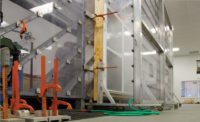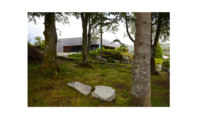Rainscreen Selected for “Meaningful” Aesthetic at State-of-the-Art Innovation Hub

Photo courtesy of Sto Corp.
Innovation drives progress. And in Amarillo, Texas, there is a new hub for innovation on the campus of Amarillo College. It is called Innovation Outpost, and the building’s renovation nods to the past with an eye on the future. The structure, which was the former site of Amarillo High School, holds significant meaning in the community, and it has now been rehabbed with innovative, high-performance, industry-leading products that illustrate the purpose of the new space.
Creating a Defining Structure
Parkhill was the architecture firm in charge of the building’s design and product specification, and it collaborated with Dr. Russell Lowery-Hart, president of Amarillo College, who spearheaded the development of the innovation center. Parkhill presented a number of creative ideas for the building and conducted a series of stakeholder meetings with the college to discover what kind of structure would be beneficial for the local communities.
Ultimately, Parkhill presented a concept package that allowed the college to apply for an EDA grant, which is distributed by the Economic Development Administration and is designed to support projects that contribute to job creation, innovation and economic improvement.
With an eye toward creating a building that would define innovation, the architects and the college turned to Sto Corp. for the precise aesthetic they needed.
“We wanted a building with a modern look on both the interior and exterior,” said Danny Smith, master plan program manager at Amarillo College. “Sto’s products provide an inviting atmosphere for people to hang around outside and discuss new ideas.”
Reflecting on the Past, Seeing the Future
The project needed to be a “large box” with no windows, originally tailored to meet the needs of the proposed first tenants, who would utilize the space as a visual effects studio with 360-degree cameras. Natural light from window openings would have disrupted such an atmosphere. There was also interest from local film studios, but the building ultimately ended up serving as a performance space, similar to a Ted Talk environment.
“Our challenge was figuring out how we take that information and visually tackle it to make it meaningful as a part of the aesthetic of the building,” said Amber Buscarello, AIA, architect at Parkhill.
Buscarello and the Parkhill team had the idea of a mirrored façade, one that would allow passersby to see the rich history surrounding the building by looking at the structure itself.
“The idea behind the design is to reflect on the past while seeing what the future can be,” Buscarello explained. “Sto was the only product that truly gave us a mirrored effect.”

Photo courtesy of Sto Corp.
Performance in Sight
Parkhill specified a StoVentec Glass Rainscreen façade with a StopSol mirrored-glass finish. This allowed the company to flawlessly execute on its design vision, which was the first priority, while simultaneously providing ease of installation and long-term performance, all in an integrated system.
“For this project, we were really looking for aesthetics, but we had trust in Sto’s product performance from our previous experiences with them,” Buscarello said. “This made StoVentec an easy choice for both function and looks.”
StoVentec Glass is a high-performance, open-joint, drained, back-ventilated rainscreen wall system that combines superior air- and weather-tightness, excellent thermal performance and fire protection. The system incorporates noncombustible, continuous exterior insulation and a continuous air and moisture barrier via the StoVentro sub-construction and StoVentec Glass Panel. The end result is an advanced, high-performance wall assembly that incorporates all of the necessary control layers, sub-construction, insulation and exterior cladding from a single source: Sto. For the project team and installers, this means one supplier, one warranty and one point of contact for the exterior façade. This translates to time, labor and cost savings, as well as valuable peace of mind.

Photo courtesy of Sto Corp.
Distinguished Reflection
Innovation Outpost mirrors what Amarillo College wanted in a building representative of innovation. With the help of Sto, the structure is a campus standout, catching the eye of onlookers while reflecting Amarillo’s surrounding built environment, including the Sante Fe Building and the vivid neon sign bearing its name.
“The goal with Innovation Outpost is to foster new ideas and the collaboration to develop these new ideas,” Smith added. “The exterior of this building is designed to have people sitting around at tables discussing their ideas or listening to a speaker who is an expert in a particular field of study.”
The college and the architects at Parkhill were both pleased with the final result. Buscarello noted that, even though the original idea of a visual effects space did not come to fruition, based on the tenants, the façade is truly following the original design intent.
“It has evolved in functionality,” Buscarello added, embodying the true spirit of change and innovation.
Looking for a reprint of this article?
From high-res PDFs to custom plaques, order your copy today!





